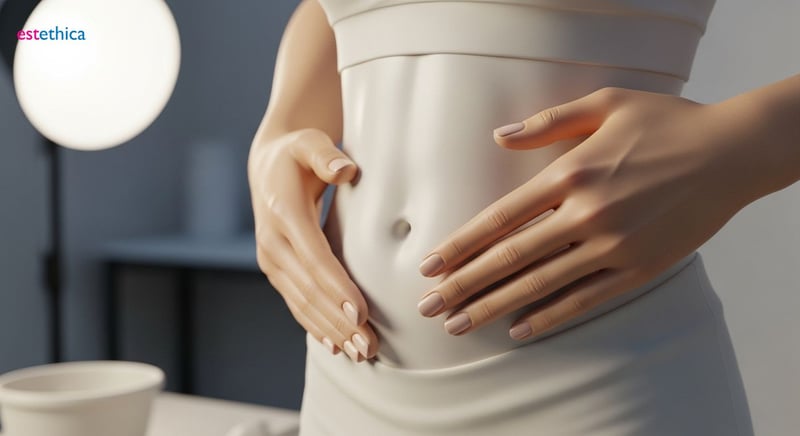Tummy Tuck Transformation: Reshape Your Body & Confidence
Unlock the secrets of tummy tuck surgery at estethica, where patient care meets advanced technology.
Discover the transformative journey of abdominoplasty, commonly known as a tummy tuck, and unveil the secrets to achieving your ideal abdominal contour. In this comprehensive guide, we'll delve into the various aspects of tummy tucks, explore the nuances of the procedure, and provide insights into post-operative care. As one of the leading names in aesthetic surgery, estethica is dedicated to offering world-class treatments with a commitment to patient safety and satisfaction.
Abdominoplasty: Understanding the Procedure & Its Variations
Exploring the Nuances of Abdominoplasty Techniques
Abdominoplasty, commonly known as a tummy tuck, is more than just a cosmetic procedure; it's a transformative surgery designed to reshape the abdomen. It involves removing excess skin and fat, and tightening abdominal muscles. The goal is to create a smoother, firmer abdominal profile. According to the American Society of Plastic Surgeons, abdominoplasty procedures have seen a steady increase in popularity, reflecting a growing desire for enhanced body contours. The surgery is particularly beneficial for individuals who have experienced significant weight loss or women who have undergone pregnancy, both of which can lead to stretched skin and weakened abdominal muscles. Understanding the different techniques available is crucial for achieving the best possible results.
- Mini Tummy Tuck: Focuses on the area below the navel, ideal for those with less excess skin. For example, a patient with a small amount of loose skin after a minor weight loss might benefit from this.
- Full Tummy Tuck: Addresses the entire abdominal area, including repositioning the navel. This is suitable for individuals with significant skin laxity and muscle separation.
- Extended Tummy Tuck: Extends the incision around the hips to address excess skin on the flanks. This is often chosen by patients who have lost a substantial amount of weight.
Each technique is tailored to the individual's specific needs, ensuring optimal results and patient satisfaction. The choice of technique depends on the amount of excess skin, the location of fat deposits, and the degree of muscle laxity.
The Comprehensive Process of Abdominoplasty
The abdominoplasty procedure is a detailed process that involves careful planning and execution. Muscle repair surgery is often a key component, especially for women who have experienced diastasis recti (separation of abdominal muscles) due to pregnancy. The surgeon makes an incision, the length and shape of which depend on the amount of excess skin. The skin is then lifted, and the underlying muscles are tightened and sutured together. Excess skin is removed, and the remaining skin is re-draped to create a smoother contour. A recent study highlighted that patients who undergo muscle repair during abdominoplasty experience improved core strength and posture. For instance, consider a patient who has had multiple pregnancies and wants to restore her pre-pregnancy abdominal shape. Or, imagine someone who has lost a lot of weight and wants to remove the excess skin. Or, consider a patient who wants to improve abdominal contouring. These are all great reasons for a tummy tuck.
- Consultation and Assessment: The surgeon evaluates the patient's health, discusses goals, and determines the appropriate surgical technique.
- Surgical Procedure: Involves skin removal, muscle tightening, and liposuction if necessary, to refine the abdominal contour.
- Post-operative Care: Includes pain management, wound care, and a period of recovery to allow the tissues to heal properly.
The result is a more toned and sculpted abdomen, enhancing the patient's overall body image and confidence. The procedure not only improves aesthetics but also can improve physical function and quality of life.

Muscle Repair Surgery: Restoring Core Strength After Tummy Tuck
Benefits of Muscle Repair Following Abdominoplasty
Muscle repair surgery, often a key component of a tummy tuck, addresses diastasis recti, a condition where abdominal muscles separate. This separation commonly occurs in women post-pregnancy. By stitching these muscles back together, the surgery enhances the tummy's appearance and strengthens core stability, improving posture and reducing back pain. For example, a mother of three might notice significant improvement in her posture and a reduction in back pain after undergoing muscle repair surgery as part of her tummy tuck procedure. Also, consider a patient who has had a tummy tuck and wants to improve abdominal contouring, or someone who has lost a lot of weight and wants to remove the excess skin. These are all great reasons for a tummy tuck. Muscle repair is integral to achieving a flatter, more toned abdomen and enhancing overall physical well-being.
- Improved Core Strength: By rejoining separated muscles, the surgery enhances abdominal strength, making everyday activities easier.
- Enhanced Posture: A stronger core supports the spine, leading to better posture and reduced strain on the back.
- Reduced Back Pain: Correcting diastasis recti can alleviate chronic back pain associated with weakened abdominal muscles.
Understanding the Muscle Repair Procedure
The muscle repair procedure during a tummy tuck involves carefully stitching the separated abdominal muscles back together. This process not only flattens the abdomen but also restores the natural support structure of the core. Imagine a corset being tightened; similarly, the muscles are brought closer together and secured, creating a firmer abdominal wall. For instance, a woman who has experienced multiple pregnancies might find that her abdominal muscles have become significantly stretched and separated. In such cases, muscle repair surgery can make a dramatic difference. Or, consider a patient who has had a tummy tuck and wants to improve abdominal contouring, or someone who has lost a lot of weight and wants to remove the excess skin. These are all great reasons for a tummy tuck. The procedure is performed with precision to ensure long-lasting results and improved functionality.
- Incision and Muscle Exposure: The surgeon makes an incision to access the abdominal muscles.
- Muscle Suturing: The separated muscles are carefully brought back together and stitched securely.
- Closure: The skin is re-draped, and the incision is closed, resulting in a smoother, more toned abdomen.

What to Expect: Navigating Your Tummy Tuck Recovery Journey
Essential Steps for a Smooth Tummy Tuck Recovery
Recovery from a tummy tuck, or abdominoplasty, is a critical period that requires careful attention and adherence to your surgeon's instructions. The initial days post-surgery typically involve managing discomfort with prescribed medication and ensuring proper wound care. As the days progress, swelling and bruising gradually subside, but it's essential to avoid strenuous activities to allow the tissues to heal properly. Patients often find that wearing a compression garment helps to minimize swelling and support the abdominal area. A successful recovery hinges on diligent self-care and regular follow-up appointments with your surgeon. For instance, consider a patient who carefully follows all post-operative instructions, attends all follow-up appointments, and avoids strenuous activities during the initial recovery period. Or, imagine someone who has had a tummy tuck and wants to improve abdominal contouring, or someone who has lost a lot of weight and wants to remove the excess skin. These are all great reasons for a tummy tuck. Approximately 85% of patients report high satisfaction with their tummy tuck results when they closely adhere to the recommended recovery protocol.
- Wound Care: Keep the incision site clean and dry to prevent infection. Follow your surgeon's instructions for dressing changes.
- Pain Management: Take prescribed pain medication as directed to manage discomfort during the initial days after surgery.
- Compression Garment: Wear the provided compression garment to minimize swelling and support the abdominal area.
Dietary and Activity Guidelines Post-Abdominoplasty
Following specific dietary and activity guidelines is crucial for a successful tummy tuck recovery. In terms of diet, focusing on nutrient-rich foods that promote healing, such as lean proteins, fruits, and vegetables, can aid in tissue repair. Staying hydrated is also essential to maintain skin elasticity and overall health. Regarding activity, it's important to avoid strenuous exercises and heavy lifting for several weeks to prevent complications. Gentle walking is often encouraged to promote circulation and prevent blood clots. Imagine a patient who incorporates a balanced diet rich in vitamins and minerals, stays well-hydrated, and gradually increases their activity level as advised by their surgeon. Or, consider a patient who has had a tummy tuck and wants to improve abdominal contouring, or someone who has lost a lot of weight and wants to remove the excess skin. These are all great reasons for a tummy tuck. A balanced approach to diet and activity significantly contributes to a smoother and faster recovery.
- Nutrient-Rich Diet: Focus on lean proteins, fruits, and vegetables to support tissue repair and overall healing.
- Hydration: Drink plenty of water to maintain skin elasticity and promote overall health.
- Gradual Activity: Start with gentle walking and gradually increase activity level as advised by your surgeon.

Does a Tummy Tuck Remove Stretch Marks? Unveiling the Truth
The Impact of Tummy Tuck on Stretch Marks
A tummy tuck, or abdominoplasty, is primarily designed to remove excess skin and fat from the abdominal area, and it can have a positive effect on stretch marks. The procedure involves excising the lower abdominal skin, which often contains a significant number of stretch marks. When this skin is removed, the remaining skin is stretched and sutured together, resulting in a smoother abdominal surface. While a tummy tuck can significantly reduce the appearance of stretch marks, especially those located in the lower abdomen, it is important to understand that it is not specifically a stretch mark removal procedure. For example, a patient with numerous stretch marks below the navel might see a substantial reduction in these marks after a tummy tuck. The goal is to improve abdominal contouring. Also, consider a patient who has had a tummy tuck and wants to improve abdominal contouring, or someone who has lost a lot of weight and wants to remove the excess skin. These are all great reasons for a tummy tuck.
- Removal of Affected Skin: Tummy tucks excise skin with stretch marks, particularly in the lower abdomen.
- Skin Tightening: The remaining skin is stretched, reducing the appearance of stretch marks.
- Contour Improvement: Overall abdominal contour is enhanced, making stretch marks less noticeable.
Factors Influencing Stretch Mark Reduction
The extent to which a tummy tuck can remove stretch marks depends on several factors, including the location and severity of the stretch marks, as well as the amount of skin that can be safely removed. Stretch marks located on the skin that is excised during the procedure are most likely to be eliminated. However, stretch marks located above the navel or on the flanks may not be significantly affected. The elasticity of the skin also plays a crucial role; more elastic skin tends to yield better results. It's important for patients to have realistic expectations and understand that while a tummy tuck can improve the appearance of stretch marks, it may not completely eliminate them. For instance, a patient with stretch marks primarily located below the navel is likely to see a greater reduction compared to someone with stretch marks extending to the upper abdomen. Also, consider a patient who has had a tummy tuck and wants to improve abdominal contouring, or someone who has lost a lot of weight and wants to remove the excess skin. These are all great reasons for a tummy tuck.
- Location of Stretch Marks: Marks on the lower abdomen are more likely to be removed.
- Skin Elasticity: More elastic skin results in better stretch mark reduction.
- Amount of Skin Removed: The extent of skin excision influences the degree of stretch mark removal.
Advanced Abdominoplasty Techniques for Enhanced Abdominal Contouring
estethica employs a range of abdominoplasty techniques, including mini, full, and extended tummy tucks, tailored to individual patient needs. Muscle repair surgery addresses diastasis recti, restoring core strength and improving posture.
estethica’s surgeons are highly skilled in abdominoplasty, ensuring optimal results and patient satisfaction. The team's detailed process involves careful planning and execution, focusing on muscle repair and skin redraping to create a smoother contour.
Comprehensive Post-operative Care for Smooth Tummy Tuck Recovery
estethica provides comprehensive post-operative care, including wound management, pain control, and compression garments. Dietary and activity guidelines are provided to promote healing and minimize complications, contributing to a smoother and faster recovery.
Patients at estethica benefit from a more toned and sculpted abdomen, enhancing overall body image and confidence. The procedure can improve physical function and quality of life, with a focus on patient safety and health.
Frequently Asked Questions
What is a Tummy Tuck (Abdominoplasty) and who is it for?
What does Muscle Repair Surgery during a Tummy Tuck involve?
What is the Tummy Tuck Recovery process like?
Does a Tummy Tuck remove Stretch Marks?
What are the different types of Abdominoplasty procedures?
Achieve your aesthetic goals with estethica's personalized care and cutting-edge treatments.
📞 Schedule Your Free Consultation!